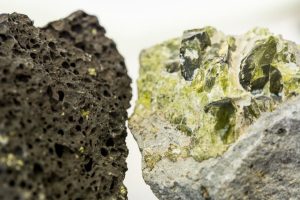
Volcanoes are an explosive and mysterious process by which molten rock from Earth’s interior escapes back into the atmosphere. Why the volcano erupts — and where it draws its lava from — could help trace the lifecycle of materials that make up our planet.
New University of Washington research shows that a common type of volcano is not just spewing molten rock from the mantle, but contains elements that suggest something more complicated is drawing material out of the descending plate of Earth’s crust.
Geologists have long believed that solidified volcanic lava, or basalt, originates in the mantle, the molten rock just below the crust. But the new study uses detailed chemical analysis to find that the basalt’s magnesium — a shiny gray element that makes up about 40 percent of the mantle but is rare in the crust — does not look like that of the mantle, and shows a surprisingly large contribution from the crust. The paper was published the week of June 13 in the Proceedings of the National Academy of Sciences.
“Although the volcanic basalt was produced from the mantle, its magnesium signature is very similar to the crustal material,” said lead author Fang-Zhen Teng, a UW associate professor of Earth and space sciences. “The ocean-floor basalts are uniform in the type of magnesium they contain, and other geologists agree that on a global scale the mantle is uniform,” he said. “But now we found one type of the mantle is not.”
The study used rock samples from an inactive volcano on the Caribbean island of Martinique, a region where an ocean plate is slowly plunging, or subducting, beneath a continental plate. This situation creates an arc volcano, a common type of volcano that includes those along the Pacific Ocean’s “Ring of Fire.”
Researchers chose to study a volcano in the Caribbean partly because the Amazon River carries so much sediment from the rainforest to the seabed. One reason scientists want to pin down the makeup of volcanic material is to learn how much of the carbon-rich sediment from the surface gets carried deep in the Earth, and how much gets scraped off from the descending plate and reemerges into the planet’s atmosphere.
Analyzing the weight of magnesium atoms in the erupted basalt shows that they came not from the mantle, nor from the organic sediment scraped off during the slide, but directly from the descending oceanic crust. Yet the volcanic basalt lacks other components of the crust.
“The majority of the other ingredients are still like the mantle; the only difference is the magnesium. The question is: Why?” Teng said.
The authors hypothesize that at great depths, magnesium-rich water is squeezed from the rock that makes up Earth’s crust. As the fluid travels, the surrounding rock acts like a Brita filter that picks up the magnesium, transferring magnesium particles from the crust to the mantle just below the subduction zone.
“This is what we think is very exciting,” Teng said. “Most people think you add either crustal or mantle materials as a solid. Here we think the magnesium was added by a fluid.”
Fluids seem to play a role in seismic activity at subduction zones, Teng said, and having more clues to how those fluids travel deep in the Earth could help better understand processes such as volcanism and deep earthquakes.
He and co-author Yan Hu, a UW doctoral student in Earth and space sciences, plan to do follow-up studies on basalt rocks from the Cascade Mountains and other arc volcanoes to analyze their magnesium composition and see if this effect is widespread.
The other co-author is Catherine Chauvel at the University of Grenoble in France. The research was funded by the U.S. National Science Foundation and the French National Research Agency.
Note: The above post is reprinted from materials provided by University of Washington. The original item was written by Hannah Hickey.










